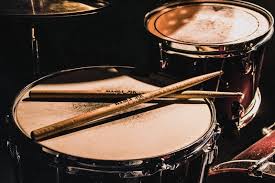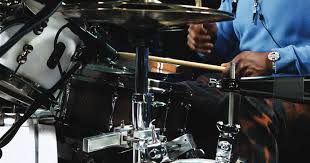Drumming is an essential element of modern music, shaping rhythm, intensity, and groove across various genres. Among the many techniques drummers use to create complex and dynamic rhythms, blast beats, ghost notes, and polyrhythms stand out as some of the most influential. These techniques allow drummers to push creative boundaries, enhance their musical expressiveness, and add unique textures to their playing. This article explores the importance of these techniques, their applications, and how they have influenced modern drumming styles.

Understanding Blast Beats, Ghost Notes & Polyrhythms
What Are Blast Beats?
Blast beats are an aggressive and high-speed drumming techniques commonly found in extreme metal and hardcore punk music. This technique involves rapid, alternating strokes between the snare and bass drum, creating an intense wall of sound. The most common types of blast beats include:
- Traditional Blast Beat: The snare and bass drum are played at the same time with alternating hands.
- Hammer Blast Beat: Both hands strike the snare drum simultaneously while the bass drum keeps a steady pulse.
- Gravity Blast: A one-handed snare roll technique using bounce or gravity to create rapid strokes.
Blast beats require endurance, precision, and coordination, making them one of the most demanding drumming techniques. Drummers like Pete Sandoval (Morbid Angel) and Flo Mounier (Cryptopsy) have mastered this style, influencing generations of drummers.
What Are Ghost Notes?
Ghost notes are subtle, quieter strokes played on the snare drum that add depth and groove to drumming patterns. These notes are barely audible in comparison to primary beats but are essential for creating dynamic contrast and a sense of flow. Ghost notes are widely used in funk, jazz, and rock drumming to add texture and rhythmical sophistication.
Some key characteristics of ghost notes include:
- Soft strokes played close to the drumhead.
- Used to create syncopation and groove in various drumming styles.
- Require finger control and wrist movement for proper execution.
Drummers such as Steve Gadd and Bernard Purdie have popularized ghost notes, integrating them into legendary grooves that have influenced countless musicians.
What Are Polyrhythms?
Polyrhythms occur when two or more contrasting rhythmic patterns are played simultaneously. This technique challenges conventional timing by overlaying rhythms that do not naturally fit within the same time signature.
Common examples of polyrhythms include:
- 3:2 Polyrhythm: Three beats played against two beats in the same measure.
- 4:3 Polyrhythm: Four beats played against three beats.
- 5:4 Polyrhythm: A complex pattern where five beats fit into a four-beat structure.
Polyrhythms are heavily used in jazz, progressive rock, and world music. Drummers like Gavin Harrison (Porcupine Tree) and Tony Williams have pioneered the use of polyrhythms to create intricate and compelling drumming compositions.
How These Techniques Shape Modern Drumming
Impact on Metal and Extreme Music
Blast beats have become a defining feature of metal drumming, pushing the genre’s speed and intensity to new levels. Bands like Napalm Death, Slayer, and Cannibal Corpse rely heavily on blast beats to drive their aggressive sound. As metal continues to evolve, blast beats remain a staple in drumming, influencing new generations of percussionists.
The Role of Ghost Notes in Funk and Rock
Ghost notes provide rhythmic depth and feel, particularly in genres like funk, jazz, and rock. The legendary “Purdie Shuffle,” played by Bernard Purdie, showcases the effectiveness of ghost notes in creating a rolling groove. Modern drummers like Mark Guiliana and David Garibaldi continue to explore and refine ghost note techniques, integrating them into contemporary drumming styles.
Polyrhythms in Progressive and Fusion Music
Polyrhythms are a fundamental part of progressive rock, fusion, and experimental music. Drummers in bands like Tool, Dream Theater, and Meshuggah utilize polyrhythms to craft complex and unpredictable song structures. This technique challenges drummers to think beyond traditional timing, expanding their rhythmic vocabulary and creative potential.
Learning and Mastering These Techniques
Tips for Playing Blast Beats
- Start slow and build speed gradually using a metronome.
- Develop hand and foot endurance through consistent practice.
- Use proper stick grip and drum placement to minimize fatigue.
- Experiment with different blast beat variations to expand your technique.
Tips for Mastering Ghost Notes
- Practice soft strokes on a practice pad to improve control.
- Work on dynamic balance between ghost notes and primary beats.
- Incorporate ghost notes into grooves by experimenting with different placements.
- Listen to drummers known for ghost note mastery and analyze their playing.
Tips for Understanding Polyrhythms
- Break down polyrhythms into smaller subdivisions.
- Count out loud to internalize the rhythm.
- Use a metronome to lock in both rhythmic patterns.
- Practice polyrhythms slowly before increasing speed.
FAQs
1. How long does it take to learn blast beats?
Blast beats require endurance and control, and it can take months or even years to master. Regular practice, proper technique, and gradual speed increases help in building proficiency.
2. Can ghost notes be applied to any drumming style?
Yes! While ghost notes are most common in funk, jazz, and rock, they can be used in nearly any genre to add subtle rhythmic variation and depth.
3. Are polyrhythms difficult to learn?
Polyrhythms can be challenging at first, but with consistent practice and breaking them into smaller sections, drummers can gradually understand and execute them more easily.
4. Which drummers are known for using all three techniques?
Drummers like Thomas Lang, Jojo Mayer, and Virgil Donati are well-known for incorporating blast beats, ghost notes, and polyrhythms into their playing, pushing the boundaries of modern drumming.
Blast beats, ghost notes, and polyrhythms are three powerful drumming techniques that add speed, subtlety, and complexity to music. Whether you’re playing in an extreme metal band, a funk ensemble, or a progressive rock group, mastering these techniques can elevate your drumming skills and open new creative possibilities. By understanding their applications and practicing regularly, drummers can refine their craft and continue to shape the evolution of modern drumming. Keep exploring, experimenting, and pushing your rhythmic boundaries!
